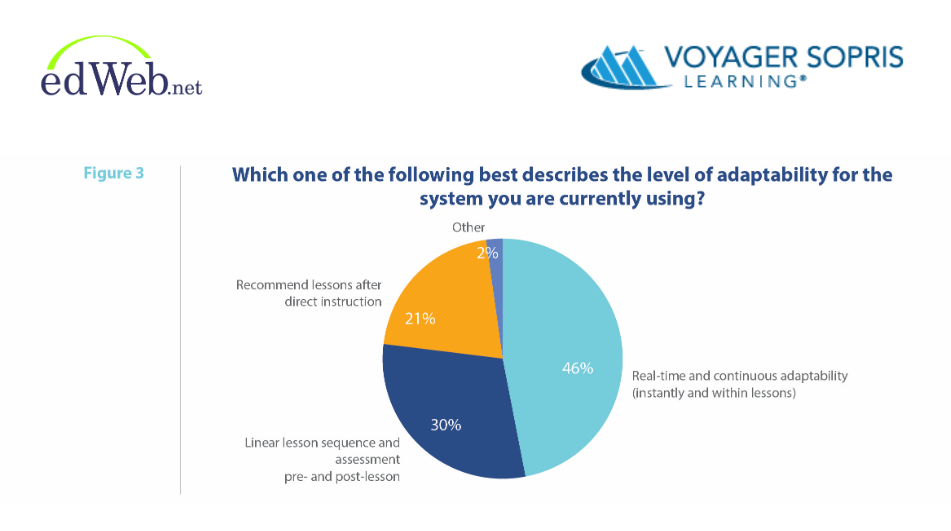The use of differentiated instruction to individualize each student’s learning experience is becoming more common in today’s elementary classrooms, but creating meaningful differentiation for a typical class of 25 students or more can still be a challenge. What should educators and administrators know about adaptive learning?
In “Adaptive Literacy Learning 101,” presenters reviewed findings from Tech & Learning’s 2017 survey on adaptive learning and highlighted key points that everyone should know.
1. Value is Abundant
The survey found that instructional leaders overwhelmingly saw the value of adaptive learning to help individualize instruction. About 85 percent of K-8 educators and administrators thought of personalization when they heard the phrase “adaptive learning.”
This figure jumped to 95 percent among district personnel. Survey respondents also rated “offers personalized/individualized learning” as most important in a list of adaptive learning system benefits.
These results indicate that K-8 educators and administrators who want to provide differentiated instruction in subjects like reading and math should look to adaptive learning software, especially in large classrooms.
2. Use is Becoming More Sophisticated
The use of adaptive learning in grades K-8 is not only on the rise, but becoming more sophisticated.
Almost two-thirds of K-8 leaders are using adaptive learning software in their school or district; in 2013, this number was only about 40 percent. Nearly half of survey respondents said their solutions provide real-time and continuous adaptability.

On average, schools use adaptive learning solutions for three days a week, 30 minutes each day, and almost 70 percent of educators say their students also access adaptive learning solutions from home at least occasionally. Since not all adaptive learning systems are the same, educators should look for highly sophisticated learning systems with real-time adaptability built into instruction, rather than having to wait for periodic assessment.
3. Barriers to Implementation Still Exist
Although the use of adaptive learning tools is growing among K-8 schools, some barriers still remain.
K-8 leaders who are not using these solutions cited budget issues as the top reason why. 60 percent of those who are using these solutions said training teachers to use the systems is their top challenge.

Having the time to implement the software was rated second highest. Because training and time are key barriers, schools should look for adaptive learning solutions that are easy to use and implement, and that generate easy-to-understand data and insights, which help to make instruction that much more targeted and effective.
About the Presenter
Lauren Kimlinger is a first grade teacher and technology and math instructional leader at Boise-Eliot Elementary School in Portland, OR, with a fierce passion for edtech. She has a Bachelor of Arts in sociology from Oberlin College and a Masters of Arts in teaching from Concordia University. During her seven years of teaching kindergarten, Lauren became fascinated by the mind-boggling choices in the emerging edtech market. Through experimenting with new technologies, observing students and their data, and learning about blended learning, Lauren has made her own practice very much about meeting students exactly where they are and giving them their next step. Utilizing all available methods: technology, small groups, one-on-one conferences, alternative means of assessment and group project work and more, Lauren intends every year to step out of students’ ways and allow them to meet their potential.
Join the Community
Adaptive Literacy Learning is a free professional learning community that helps educators realize and experience the value of adaptive learning in individualizing instruction and propelling K–5 students to achieve at or beyond grade level.
This broadcast was hosted by edWeb.net and sponsored by Voyager Sopris Learning®.
The recording of the edWebinar can be viewed by anyone here.
[Editor’s note: This piece is original content produced by edWeb.net. View more edWeb.net events here.]
- #4: 25 education trends for 2018 - December 26, 2018
- Video of the Week: Dealing with digital distraction in the classroom - February 23, 2018
- Secrets from the library lines: 5 ways schools can boost digital engagement - January 2, 2018


